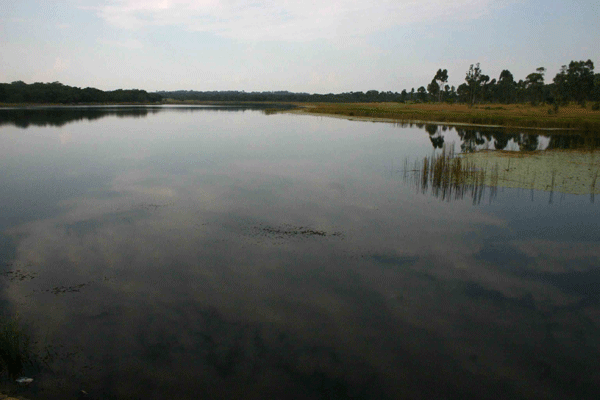
One of Zimbabwe’s seven Ramsar sites — Cleveland Dam — a reservoir located about 12km from Harare central business district constructed way back in 1913 primarily to ensure water supplies as the dam flows into Lake Chivero with the water thereafter distributed to people in Harare, Chitungwiza, Ruwa and Norton — is under serious threat. Harare City Council has reportedly allocated stands along the edge of the swampy catchment area.
environment By Chipo Masara
An environmentally conscious group put together by Environment Africa, known as the Environment Action Group — who for years have been committed to the preservation of the important site — are starting to feel they may be fighting a losing battle. In spite of their objecting to the developments, caterpillars are already working the area at the edge of the site leading to the Donnybrook race course, with the indiscriminate cutting down of trees and other vegetation changing the setup of the ecologically-sensitive area.
In a bid to establish the stance of the Environmental Management Agency (EMA) on the developments at the Ramsar site, The Standard Style’s environment reporter Chipo Masara (CM) caught up with Environmental Management Agency (EMA’s) publicity officer Steady Kangata (SK). Below are excerpts of the interview.
CM: How committed is EMA to preserving wetlands?
SK: EMA is outrightly committed to the conservation or wise use of wetlands as drawn from its mandate or purpose of life as given in the Environmental Management Act (Cap 20:27) where the agency is there to ensure the sustainable management of natural resources and protection of the environment as well as come up with plans for the prevention of pollution and degradation.
CM: What is the proof of the commitment, considering all the wetlands have either been completely destroyed or are under threat?
- Chamisa under fire over US$120K donation
- Mavhunga puts DeMbare into Chibuku quarterfinals
- Pension funds bet on Cabora Bassa oilfields
- Councils defy govt fire tender directive
Keep Reading
SK: It is an overstatement that the country’s wetlands have been completely destroyed. The country has approximately 1 117 wetlands that cover some 793 348 hectares or 1,5% of the country’s land area. A total of 60% of this area is communal and resettlement areas. The wetlands of Harare and Chitungwiza admittedly are under threat from infrastructural development such as malls, churches and houses.
EMA’s commitment to wetland conservation is reflected in principle by the policy and legal framework in place to govern wetland utilisation. Zimbabwe is signatory to the Ramsar Convention on Wetland Conservation, which the country acceded in 2012 responding to international obligations on wise use of wetlands with national action and international cooperation. At national level, the Environmental Management Act, section 113 is dedicated to wetland conservation as well as section 20 of Statutory Instrument 7 of 2007 [Environmental Management (EIA and Ecosystems Protection)] Regulations of 2007. In order to craft a good wetland management strategy for the country, EMA conducted a national survey to compile a wetland resources inventory. This resulted in the agency coming up with a wetland map of Harare and Chitungwiza to guide the local authorities and developers on the status of the land to avoid ecologically sensitive areas such as wetlands.
CM: I am was told that you know about the developments that are taking place at the Cleveland Dam catchment area. What does EMA have to say about these developments?
SK: Such developments are not good for the integrity of wetlands. Real Estate developments are sanctioned by the local authority and in this case, City of Harare. They have since appeared before the Environmental Management Board hearing for this issue and others, and a verdict was passed directing them to redress the matter. It is going to be a thing of the past as we are now working closely with the local authorities to jointly save the remaining wetlands because of their importance in risk reduction in the event of extreme climatic events brought by climate change such as droughts and floods.
CM: EMA clearly stipulates that before any such project can commence, an EIA [Environmental Impact Assessment] has to be conducted to determine how safe it is to give the project the green light. Have the reported developments on the wetland been allowed by EMA to go on?
SK: No. Thus why the city fathers were called for a hearing and directed to redress the matter.
CM: Does EMA in fact have the power to stop such developments, assuming that they are illegal?
SK: Yes, EMA does have the power and it is following all due procedure in doing so but unfortunately, the environmental laws are silent on demolitions.
CM: What has been limiting EMA from showing real teeth when it comes to issues to do with environmental protection?
SK: At times some people have extreme expectations from EMA. The wheels of justice are rather slow. As EMA, we follow the legal procedure in addressing anomalies whereby we stop further damage, punish the offender for the malpractice and prescribe corrective measures allowing reasonable time that accords even the offenders natural justice for their side to be heard. Furthermore, EMA is there to enforce the provisions of an Act of Parliament. Some issues end up being adjudicated by the courts of law and we abide by the legal procedures of the land. The fines are, however, not deterrent to local authorities and institutions as the maximum is $5 000. Amendments are at an advanced stage for the inclusion of the corporate veil in the laws so that heads of institutions are held accountable both in their institutional and personal capacities.
CM: There are some who would like to think that EMA is reactive and only comes in when things are bad instead of being proactive and making sure environmental destruction does not happen in the first place. What do you say to such views?
SK: I take that as an opinion or perception and not a fact or assertion. Every regulatory authority is both proactive in avoiding certain future malpractices and reactive to already committed issues. The EIA is a good example showing how proactive EMA is. Several possible adverse impacts of developmental projects have been avoided through the EIA process and because the public did not experience them, they can decide not to talk about them.
I say, EMA is very proactive and has protected the nation in many ways where there was potential of adverse impacts which could have been worse in the absence of EMA.











